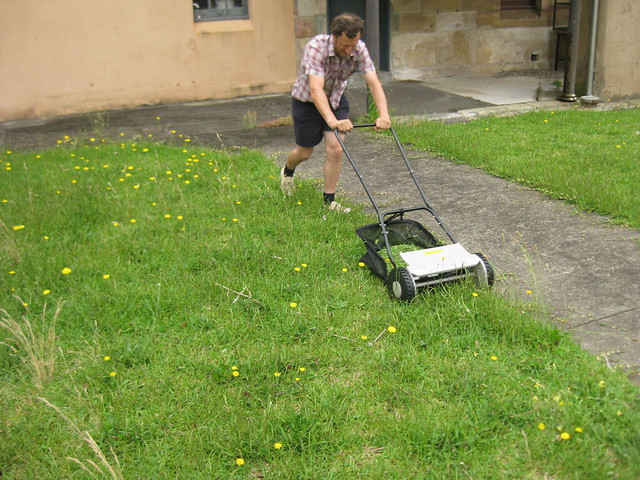
Sent:
22 March 2011
17:05:38Today’s desk
calendar
quote… ‘Grass is
the forgiveness of
nature – her
constant
benediction.
Forests decay,
harvests perish,
flowers vanish, but
grass is immortal’.
–Brian Ingalls xSender:
Lisa Kelly


Sent:
22 March 2011
17:05:38Today’s desk
calendar
quote… ‘Grass is
the forgiveness of
nature – her
constant
benediction.
Forests decay,
harvests perish,
flowers vanish, but
grass is immortal’.
–Brian Ingalls xSender:
Lisa Kelly
[LUCAS]:
A few years ago, my gardening buddy Lisa Kelly did a project called The Lively Plane. It was all about Plane Trees, also known as London Plane Trees. These are the deciduous fellows you see planted around the streets of inner Sydney, they grow big and tall, they are very resilient to soil compaction, they filter summer light and let in the winter light, they drop huge quantities of seedpods which get up everyone’s allergic noses, they’re loved and hated.
Lisa collected a large quantity of fallen Plane seeds, and lovingly hand-germinated them. The germination rate wasn’t high, but enough survived for her to raise a small army of potted trees.

[Lisa watering her Plane Trees, on the balcony of her studio above First Draft Gallery, early 2009]
These were exhibited as part of the exhibition There Goes the Neighbourhood at Performance Space, and many of the potted saplings were distributed to friends and interested visitors after the show finished. (Here’s a page on Lisa’s blog about the project…)
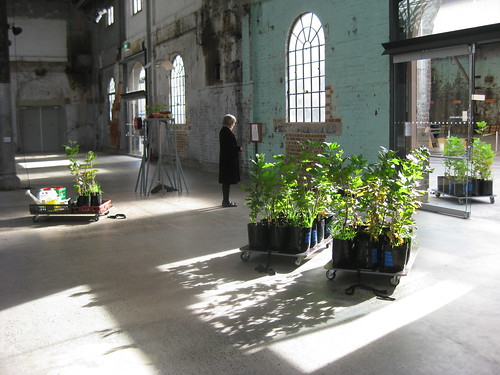
[Lisa Kelly installation view at Performance Space, 2009]
On a recent visit to Lisa’s yard, she showed me that one of her planes has now naughtily “transcended” its pot, put roots in the soil and shot 9 feet in the air. This could potentially become a problem… But I digress…
The main point of this story is coming! So, the other thing that Lisa brought along to her project was a fascination with these particular steel “tree guards” which she had noticed down at The Block in Redfern. They were kind of modernist in design, but hand-made, not standard council issue. They were designed, it seemed, to stop trees being chopped or run over. Lisa studied them, measured them, and drew up plans for a re-fabrication of them by a local ironmonger. The re-issued tree-guards joined the budding plane trees in the exhibition:
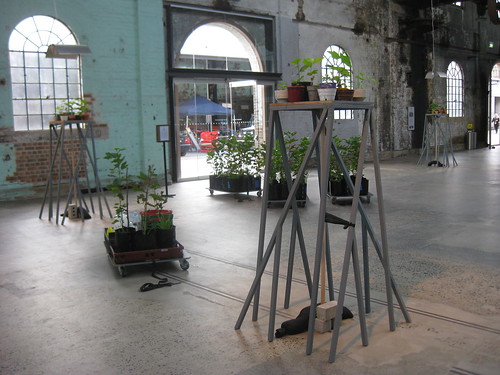
But, like the few plane trees which didn’t find new homes, the steel tree guards ended up in Lisa’s backyard, where they’ve been cheerfully rusting ever since.
Lisa and I decided they could probably find a new life with us at TENDING, (aka refugee reception centre for botanical art projects). So a few weeks back, we schlepped them over with a ute. Lisa, in her mindful, unhurried way, spent the day with us, pottering about, keeping the tree guards in the corner of her eye they whole time, waiting for the moment when their true potential would be revealed. And then, towards the end of the afternoon, she knew what to do:
Three tree guards, three existing tall palm trees. Bingo.
So we set about reconstructing the guards around the palms:
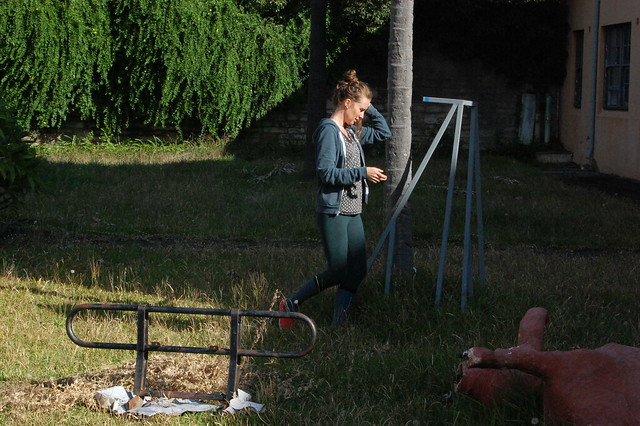
The tree guards come in two pieces and slot together.
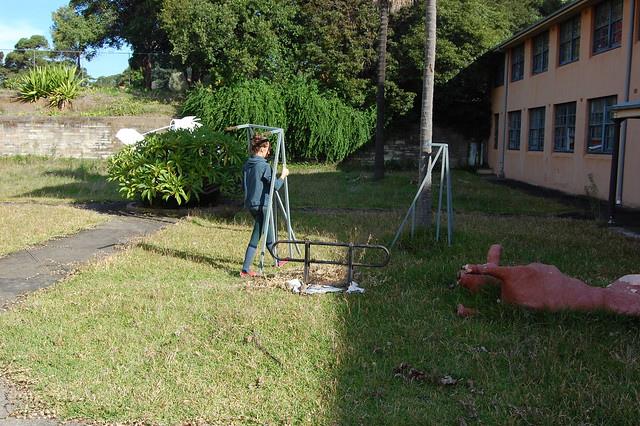
The second half slots into place.
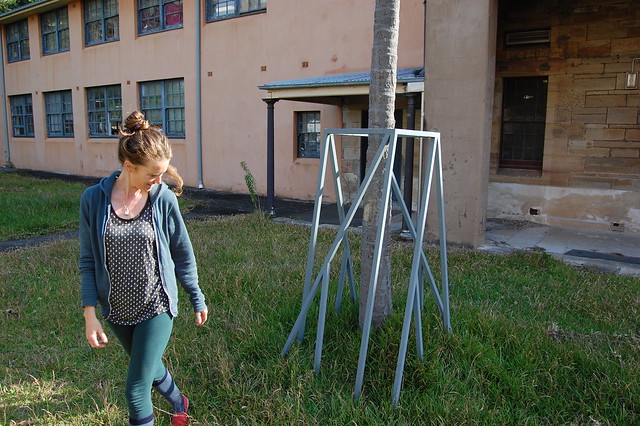
Quite pleased with this odd but fitting combination…

Photographer’s shadow, palm tree’s trunk, tree guard’s legs, artist’s legs…
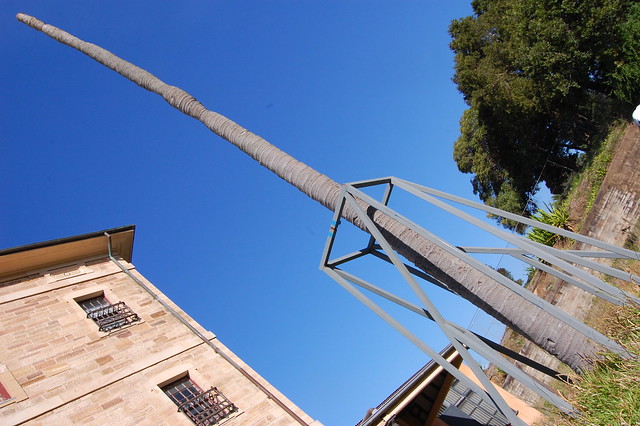
The framed obelisk…
When we had finished installing the third tree guard, we were inspecting and admiring our handywork. I guess we had never really paid much attention to these sorry looking palm trees before – especially since they seemed a bit sickly – their foliage had dropped off a few months ago during a storm, so they were just these strange misplaced wooden columns. But perhaps it was the fact that the tree guards framed the columns so nicely that made us look more closely.
And what we found was this: initials and dates, deeply inscribed on the trees.
REALLY OLD dates:
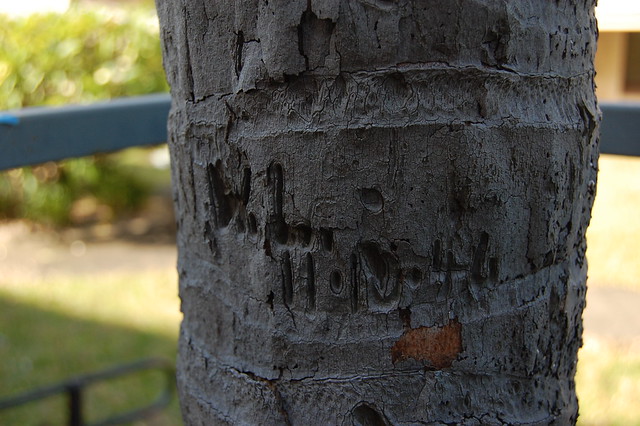
W.L. 11.10.44
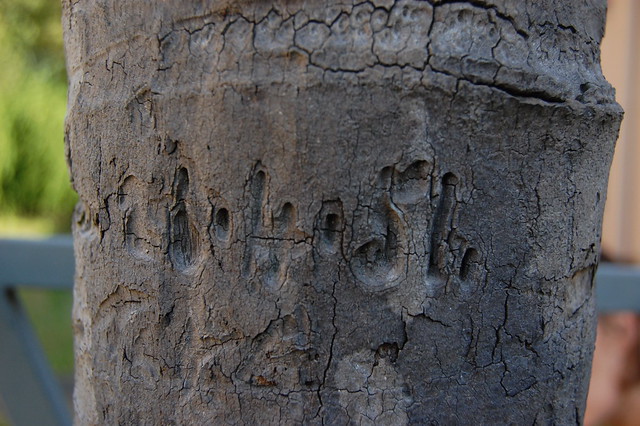
1.4.56
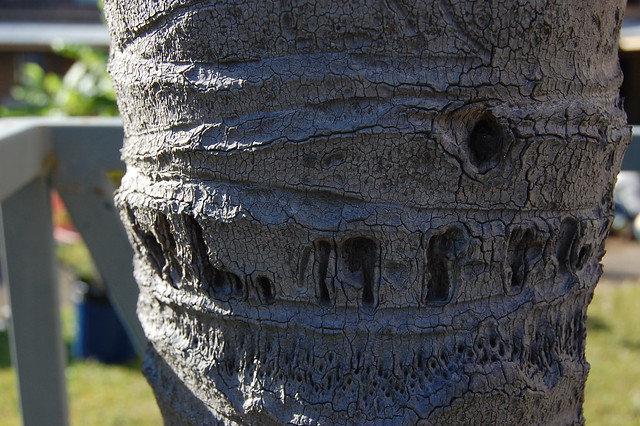
W.L. 19-8-44

DW 1.12.44
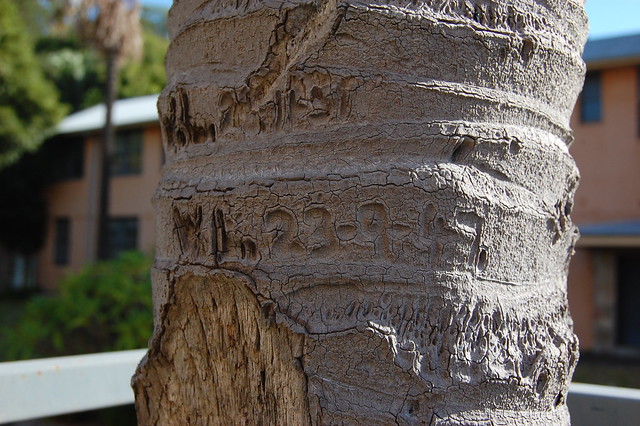
WL 23-7-47
Who were W.L. and D.W.?
…and what was going on for them in these decades, during and after the war?
Some visitors to the garden have mentioned that the SCA Library, which is right next to us, was the former housing quarters for some of the most intractable inpatients of the mental hospital (which is what the art college used to be.
What did W.L and D.W. think about? And what did they do, as they roamed the grounds?
– – –
(Lisa has posted some of these images to her own blog too…)
[DIEGO]
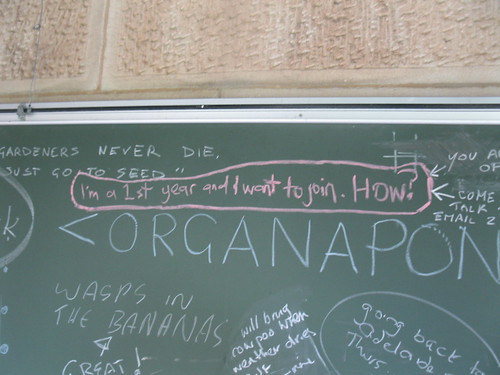
This was found on the blackboard this morning, and here is the answer I wrote.
Fortunately Liam is a clever individual, and popped in today, so to have a chat.
It’s all fine, he wanted to know what would be the procedure and where are the boundaries of involvement, for which I replied ‘none’ and ‘none’..
I mean, do consider all other’s efforts, but if you would like to do something at Tending, well, just do it. Leave traces behind, write on the board who you are, what you doing and what is your aim, and that would be pretty much it for requirements.
Just let everyone know out of courtesy what you’re doing, and then go for it.
Call out for involvements are all over, in most cases the only pre-requisite is energy and willingness, like the upcoming Agar Dish night, organised by Gemma, of SCASS, one of the Student Association groups active in the campus.
The night will be hosted in the garden, on the 18th May, applications are open now, contact g.mckenzie.booth@gmail.com as from flier below :

In the meantime, pedroTV came to visit, and did some recording, we will find out soon enough if we make it past the editing room:
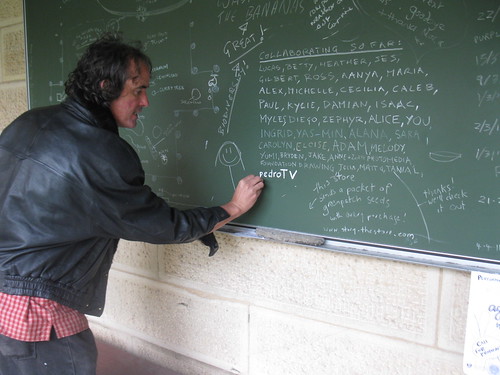
The garden is growing! thanks rain 🙂
[DIEGO]
We started the morning at Michele yesterday, helping out with a pile of soil which we spread around her garden.
Michele is the lovely lady who famously donated the banana pups for Tending.
Michele is also the producer of the Permaculture Diary and her garden is one of the most awarded and respected backyard in Sydney.
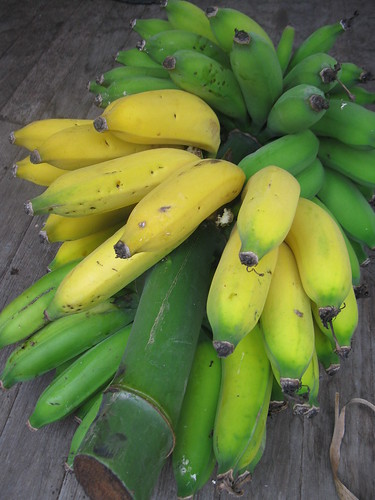
As we were chatting and shoveling we admired the enormous bananas that she just pulled down from the tree, and learned about a number of plants we never heard before.
Thinking back what to write about the experience two words kept coming back, embodiment of knowledge.
At some point, somewhere, I remember talking with someone about the aspect of embodied knowledge, I think was something about the french philosopher Michael Serres.
The fact that Michele knows so much about plants, growing, permaculture, food security and sustainable systems, is only part of the story. There is so much more knowledge that could be gathered from her only by looking at the way she spread the soil on a garden bed, the way she pull out a plant that finished its cycle, the way her body moves amongst the chickens.
Knowledge does not comes in written words alone, far from it.
As we then moved onto Tending, we welcomed Aanya again, who with little Rufus, is one of the great gardeners on the site.
We set-up a new patch, and sown beans, broccoli and garlic.
Again, her hands knew the dirt.
it is a pleasure to be reminded of how simple movements signify so much history and cultural relationships.
We were talking about the symbiotic relationship between human and weeds to keep it on the subject. The way some botanical species have adapted to us to the level of being an osmotic extension: weeds ooze out of our cultural and societal architectures.

Interestingly Bryden is keen on weeds too, and embodied knowledge.. OK this is a bit of a long shot of mine, regardless, here’s Bryden talking about his project, which comprise of a set of willows which he collected from the mountains, and which will be ‘wired-up’ with a solar-powered sound system, and here is me talking about bonsai possibilities with such plants
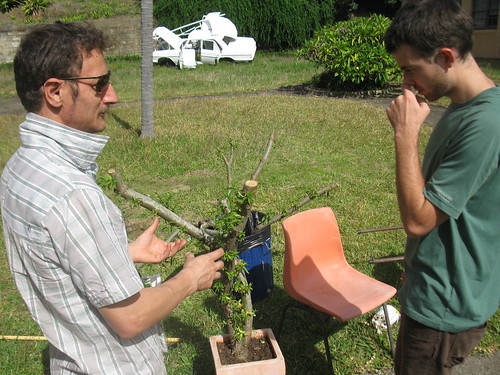
🙂
Tending on..
[LUCAS]:
These are the days gardens were made for! Glorious sunshine following more rain than Sydney has seen for years.
We were joined this morning by Lisa, who rode with us to Tending, carrying in her bike basket two small trees: a mulberry and a cherry guava. Both these elegant woody creatures had emerged unsolicited from Lisa’s compost bin. Lisa’s backyard is rather small – but she has a thing for creche-ing young trees, so she decided to bring them along to join the gang at Tending.
Although our future tenancy at Sydney College of the Arts is by no means guaranteed, I love it when people bring along plants that will take a LONG time to bear fruit, or to grow to their full potential. There’s something joyfully and recklessly optimistic about it.
When we arrived, we were greeted by Corinne, who was already hard at work digging a hole. We first met Corinne a few weeks back and had a good chat about theory and philosophy of “connected-ness to land”. This week she was more into the practice of it, getting stuck in with her gorgeous hi-tech spade (you can see it on the right in the photo above). Corinne’s not sure yet what she will plant in her modest plot. She mentioned something about bringing along some cow poo… and she donated to us two bottles of very rich looking worm juice – lovely stuff…
* * *
Whenever we arrive at TENDING, we noodle around for a while, seeing what might have changed since last week. We call this “greeting the garden”. This week we were keen to see whether our “pumpkin cages” had worked to thwart the nibbling rats which have recently been visiting. (Our few small and juicy looking watermelons, some of the cucumbers and pumpkins have been nabbed by our rodent pals before we could enjoy them.) So, using chicken wire, we crafted these (not very attractive) suits of armour for the pumpkins which remain:
…so far so good… And the hanging pumpkins seem to be out of harm’s way, for now…
Speaking of animal-vegetable interactions… there were a lot of insects in the garden this week. Wasps buzzing around the banana trees; dozens of ladybugs on the pumpkins, and unidentified crawlers like this one:
Evidently somebody else had seen the wasps, and worried about them – a shrill note was scrawled on our blackboard: “WASPS IN THE BANANAS”. Diego (our resident, self-appointed wasp expert) declared the wasps to not be a problem (yet). He responded: “GREAT! BIODIVERSITY”. (I imagine he’d revise his benevolent wasp-stance if he got stung by one of them, but there’s no use speculating on future unknowns…)
* * *
It took a while before we got around to planting Lisa’s small trees. I think she was keen to inhabit the garden for a while, sussing out what might be a good spot – after all, if everything goes according to plan, these guys will stay where they are for decades! She decided to nestle the cherry guava inside Betty’s Jungle. We found a space for it, where it will hopefully be nurtured by the surrounding plants, and eventually grow up to shelter them:
It blended in pretty well…
The mulberry, on the other hand, we decided to plump right in the middle of the lawn – not far from Gilbert’s lemongrass patch. So we cut a nice circle…
…scalped the lawn…
…discovered remnant sandstone pieces not far down (and had a chat about whether the roots of the mulberry would be able to work their way through)…
…dug in some compost and planted the tree…
Relaxing after this feat, lying on my back watching the clouds, I had a small moment of marvel, at how an organism can manage to synthesise elements from the air and the soil to produce something as wonderful as wood!
* * *
We had heaps of other visits this week, from students popping in to check whether it’d be ok for them to start their biological artworks in TENDING.
For the record, we say “Yes!” to just about everything, and we don’t even have to be there when you set it up. Just leave us a note on the blackboard. We’re looking forward to seeing what you come up with!